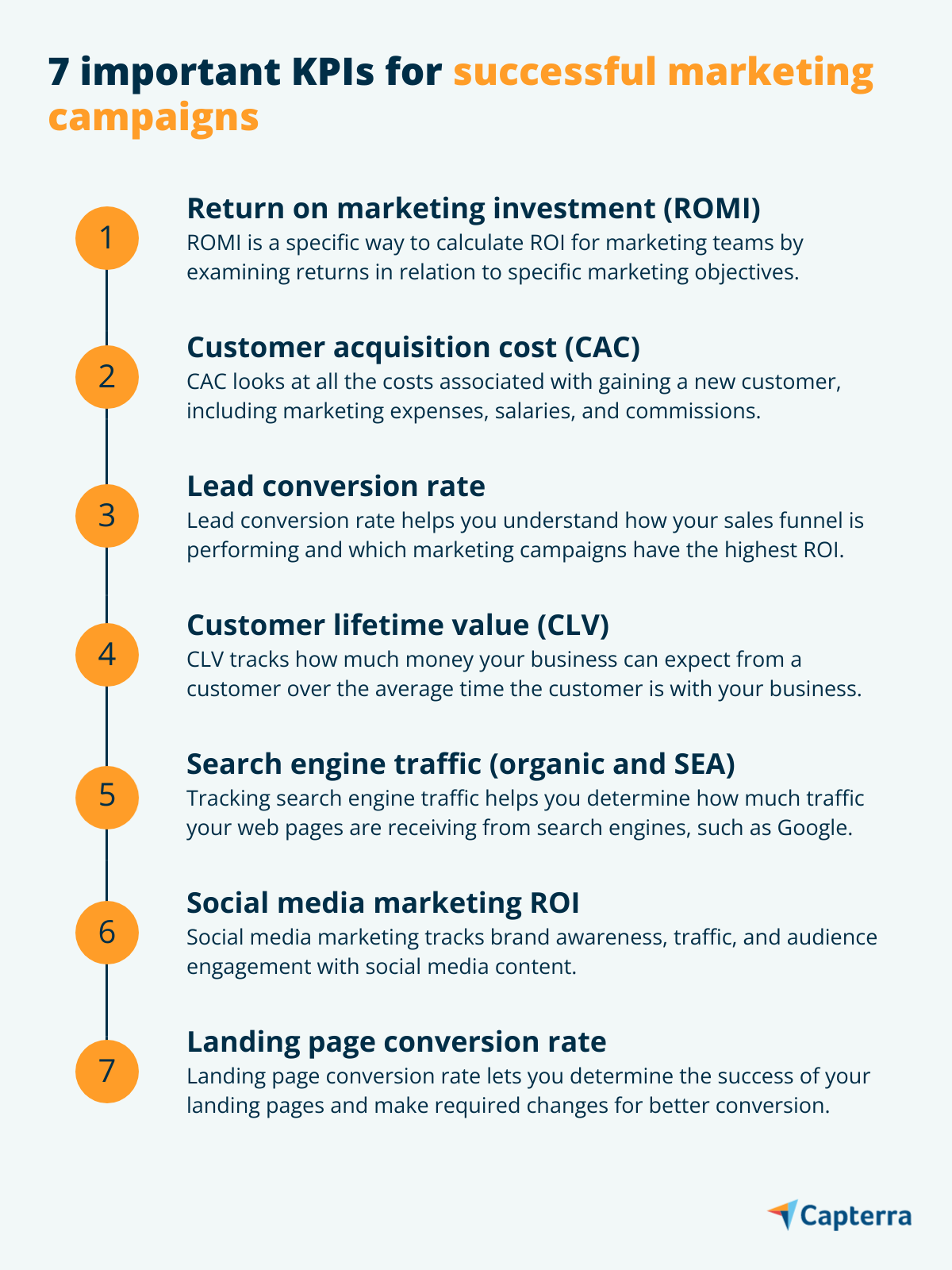Understand what KPIs are and why they’re useful for marketing campaigns to develop successful marketing strategies that generate revenue and help your brand grow.
To run a successful marketing campaign—whether it’s digital or offline—you need a firm grasp on the key performance indicator (KPI) you’ll be tracking. A KPI is a specific numeric metric used to measure progress toward a defined business goal.
Essentially, you choose a few KPIs that look at the data collected by your marketing campaign to measure whether or not it’s been successful. Without the right marketing KPIs, all you have is raw data without any context behind it. It’s all about turning the data you have into actionable insights.
Whether you’re a marketing team of one or one hundred, tracking the right KPI will help prove the value of your marketing effort as well as showcase its effectiveness over a long period.
We’ll go over seven of the most important KPIs you should track and monitor to run a successful marketing campaign. But before we get to that, let’s first understand why marketing KPIs should matter to you.
Why you should care about KPIs in marketing
Marketing KPIs are important because they help you define several things, including:
What your marketing objectives and goals are
How you will reach the said goals
How you will prove your marketing effort is producing results
What insights you need to plan future marketing initiatives
Without the granular level of detail a KPI offers, you’ll have only a bunch of data without any context or indication of why or how it’s useful for your business.
It’s not viable to support marketing strategies that don’t make money. With marketing KPIs, you’re better equipped to refine your strategies so your marketing team is making the best decisions with the data collected.

Marketing KPIs to track for more successful marketing campaigns
1. Return on marketing investment (ROMI)
ROMI is a measure of return on investment (ROI) for a marketing team. A subcategory of ROI, ROMI examines returns in relation to specific marketing objectives.
If you have a positive ROMI, your campaign is bringing in more money than you invested, which is obviously the goal and also the most important aspect your stakeholders are interested in.
ROMI informs you where to allocate your marketing budget for the best results; you can track which strategies have been the most profitable in the past.
Here’s the formula for calculating return on marketing investment:
ROMI= (Income from marketing - Marketing cost) / Marketing cost x 100
Use this calculation to track only the direct impact of your marketing campaign because you don’t want the results skewed by organic growth not related to your campaign.
2. Customer acquisition cost (CAC)
CAC looks at all the costs associated with gaining a new customer, including program and marketing expenses, salaries, commissions, software used, and any overhead related to turning a lead into a customer.
CAC helps find out how much it’s costing your business to acquire new customers via marketing campaigns, whether they’re outbound, inbound, digital, or offline.
The formula to calculate CAC is relatively simple:
CAC = (Total marketing expenses + Total sales expenses) / No. of new customers acquired
When pulling these numbers, it’s important to choose a specific time frame—could be monthly, quarterly, or yearly.
When you have a handle on CAC, you can directly account for new sales, which will help your team better allocate the marketing budget for specific areas in future campaigns.
3. Lead conversion rate
Tracking leads is one of the oldest and most basic ways of measuring sales and marketing performance, but it’s also important to determine what percentage of leads is converting into customers to understand which of your marketing efforts are the most successful.
Lead conversion rate helps you understand how your sales funnel is performing and which marketing campaigns have the highest ROI numbers.
The formula for calculating lead conversion rate is:
Lead conversion rate = (No. of leads converted / No. of leads created) x 100
Like calculating CAC, you’ll need to be specific about the period of time you choose when getting these numbers.
Track the average conversion rate of each of your marketing channels to determine which one is bringing you the most qualified leads. That will also help you decide which marketing efforts to prioritize and which to rethink to improve conversion rates in the future.
4. Customer lifetime value (CLV)
CLV tracks how much money your business can expect from a customer over the average time the customer is with your business.
Tracking and improving CLV helps reduce churn and improve customer experience. It also helps estimate a reasonable starting budget for cost per customer acquisition. When you have an idea of how much a customer will spend during the time they’re with your business, you’ll be better informed to decide how much time and effort to devote to acquiring that customer.
The formula for calculating customer lifetime value is:
CLV = Avg. sale per customer x Avg. no. of times a customer buys something per year x Avg. lifetime of a customer
This calculation provides the average CLV based on existing data. This information can be used with data from other segments you may be targeting, such as demographics or geography, to improve retention and promotional efforts.
5. Organic traffic and search engine advertising (SEA) traffic
Organic traffic, a valuable inbound marketing resource, refers to the website traffic generated by free search engines, such as Google and Bing. According to Gartner, 46% of consumers use online search as one of their first steps to finding new products (full content available to Gartner clients).
Organic traffic is directly tied to your search engine optimization (SEO) strategy, so it’s crucial to optimize your web pages for the keywords you’re hoping to capture. If leads don’t find meaningful answers to the questions that brought them to your website, they aren’t going to convert. Therefore, your web pages must have content that’s related to the keywords they’re optimized for.
Once you have a solid SEO strategy in place, organic traffic will become a consistent stream of free marketing revenue. The higher you rank, the more free website traffic you receive, and free revenue is always good.
SEA, on the other hand, is a paid marketing effort using pay-per-click (PPC) ads that are populated on various websites and search engine results pages (SERPs). Each ad that a lead clicks on costs you money. However, your ads don’t rely on organic traffic and are instead placed at the top of SERPs for the keywords you want to target.
You are guaranteed to get your ads and content marketing in front of potential customers, so you can track measurable success in a given time period.
Still confused about SEA and PPC?
Check out: What is PPC? A Basic Guide to B2B Software Pay-Per-Click Advertising
SEA and organic traffic are two sides of the same coin—both are digital marketing KPIs for your campaigns. If an ad campaign isn’t working as well as intended, you can use the collected data to adjust your SEA and SEO strategies for future campaigns.
6. Social media marketing ROI
Social media is an important part of any digital marketing strategy. It allows you to educate your audience, build brand awareness for your business, and promote your brand. In fact, social media is a great way to boost your account-based marketing strategies.
Metrics to track social media marketing performance include:
Leads converted via social media channels
Percentage of traffic across social media channels
Many different social media platforms exist between Twitter, Facebook, LinkedIn, Instagram, Pinterest, and TikTok, which can be overwhelming for small businesses that may not be familiar with the marketing strategy necessary for success on each platform. When you’re starting out, focus on one or two platforms that most resonate with your desired audience and focus your efforts there.
It’s a little hard to calculate ROI for social media, but one of the more simple ways is:
Social media ROI = (Social media marketing profits / Total cost of social media marketing efforts) x 100
Choosing the right social media KPI is important, but it’s more important to understand that the impact of a strong social media presence goes beyond just ROI. The engagement you’re seeing—whether it’s comments, reviews, or shares—is a reflection of how well your brand is perceived by your audience.
Therefore, remember making money with social media marketing is great and should be your goal, but it’s necessary to build trust and improve your brand recognition as well.
7. Landing page conversion rate
If you’ve ever made a landing page, you know how tricky it is to get good conversion rates with it. After all, a landing page that doesn’t generate leads isn’t useful, regardless of how many people visit it.
If your landing page is receiving a lot of traffic but isn’t converting many leads, you may want to consider a few changes by testing out some different strategies:
Rewrite your CTA text to make it more valuable
Change the CTA button color
Provide more value with the written content
Shorten your lead generation form to only essential, helpful information for visitors
Additional resources:
Don’t be afraid to test out different methods, one at a time, to refine your landing page strategy so you have a stellar marketing KPI to track for future campaigns.
Next step: Select the right marketing KPIs to track
We discussed seven of the most common marketing KPIs, but many more exist. When determining which marketing metric to track, it’s most important to be deliberate and thoughtful about why and how you’ll measure them.
What value will tracking a KPI bring to your marketing team? Will tracking it increase or decrease the effectiveness of your future marketing campaigns? Can you show the ROMI of your campaigns to secure more funding? Can you ideate and improve marketing strategies based on the data tracked and collected?
You should always ask yourself these questions to evolve your marketing strategies and consistently improve.
Using software is one of the best ways to track and monitor your marketing campaign’s data, metrics, and KPIs:
Marketing analytics software collects and processes the data needed for performance evaluation and strategic planning within your marketing department.
Marketing planning software helps your business outline its marketing strategy, budget, and goals as well as measure progress against these parameters.
Dashboard software allows you to connect data from different systems, applications, and departments to identify marketing trends, find correlations, and make better business decisions.
Strategic planning software aggregates historical marketing performance data and helps with creating predictive models of future performance based on specified marketing objectives and resource allocations.
Depending on your needs, you can hire services for help with your marketing campaigns. Check out our hiring guides for digital marketing agencies and marketing analytics companies to determine which one would be a better fit for you.
